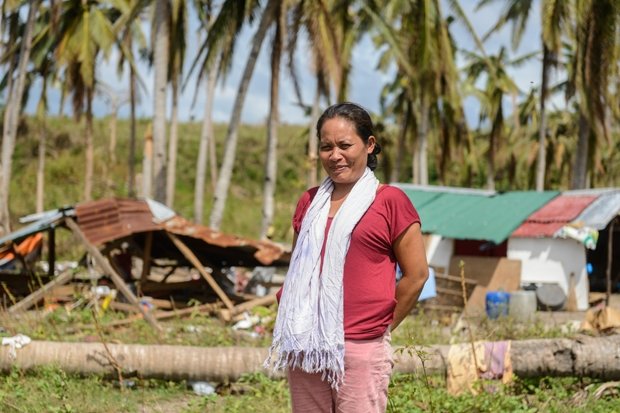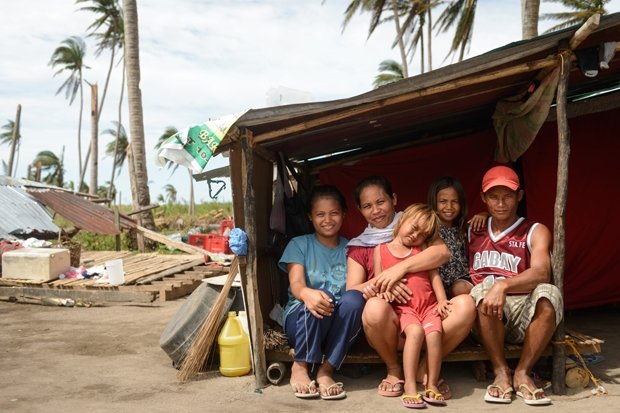By Cassandra Nelson | Director, Multimedia Projects
Kinatarcan Island, in the Visayas Sea, was in the direct path of Typhoon Haiyan when it made its fourth landfall on November 8. In the aftermath, the Capitan (chief elder) of Langub village estimated that 90% of the island was destroyed.
But as the storm approached, Sara Godon didn’t know how bad it would be. She thought her husband, Alex, and two daughters could weather it at home.
When the typhoon winds began blasting their little house, however, they realized this storm was different than the many others they had endured over the years on the island.
As their wooden house literally blew away around them, the family decided to run to the nearby school for shelter. When they reached the school they discovered it was half-destroyed and not safe. So they ran to the Capitan’s house, the best built house in the village. They joined about 50 other people who had taken up refuge there.
The following day, after the storm had passed, Sara returned to her home to find there was no home left.
Her eldest daughter, 16-year-old Shara Mae says, “We were so shocked. We all just cried silently for a few hours to get over our emotions, and then we started collecting whatever we could find from our home that had blown into the trees.”
The family built a makeshift shack next to their destroyed home for temporary shelter. They and others lived off of small rations of corn meal and rice from the Capitan’s stock for the first week, wondering if they would ever receive help.
“We heard on the radio at the Capitan’s house that ships with aid were coming, but they never came here,” Sara says.
When Mercy Corps arrived at Kinatarcan Island to distribute food packages and emergency relief supplies a few days later, we went to the Capitan to organize a system that would ensure the most vulnerable people in the community received the aid supplies first.
Although it is an extremely peaceful and friendly community, the residents on the remote island, far off main boating routes, had received almost no aid since the typhoon struck and were becoming nervous that they may not get food to survive.
We know from previous disasters that people get desperate and sometimes aggressive or hostile when they feel vulnerable and threatened. Aid distributions can become chaotic if not implemented carefully.
While we unloaded food packages and blankets, the Capitan volunteered Sara to manage the list of recipients.
“Sara is the most honest person on this island,” he said as he introduced her.
We distribute goods first to women who are pregnant or have children under 5 years of age, then to the elderly and people with disabilities, before reaching the rest of the community.
Sara turned out to be not only a totally honest person, but also incredibly organized and energetic. She ran the distribution checklist like a master of ceremonies, ensuring everyone received an aid package with dignity and efficiency.
She worked tirelessly all morning, helping her community, despite the fact that, like most people on the island, the super typhoon had taken away her home, her husband’s livelihood as a fisherman, and pretty much everything her family had.
It will be a long rebuilding process for this devastated community, but the distribution was the start of recovery for this determined woman and her neighbors.
“Finally, aid has arrived and we are so grateful,” said Sara. “We are so thankful to Mercy Corps for bringing food and some supplies. It really helps us, and now we know we are not alone.”
Thank you for empowering incredible people like Sara Godon to rebuild after Typhoon Haiyan. Together we are providing critical food, water and supplies to survivors in isolated areas like Kinatarcan Island that have yet to recieve critical aid. Your compassion reminds them that they are not alone.
Sincerely,
Cassandra Nelson
Links:
Project reports on GlobalGiving are posted directly to globalgiving.org by Project Leaders as they are completed, generally every 3-4 months. To protect the integrity of these documents, GlobalGiving does not alter them; therefore you may find some language or formatting issues.
If you donate to this project or have donated to this project, you can receive an email when this project posts a report. You can also subscribe for reports without donating.


